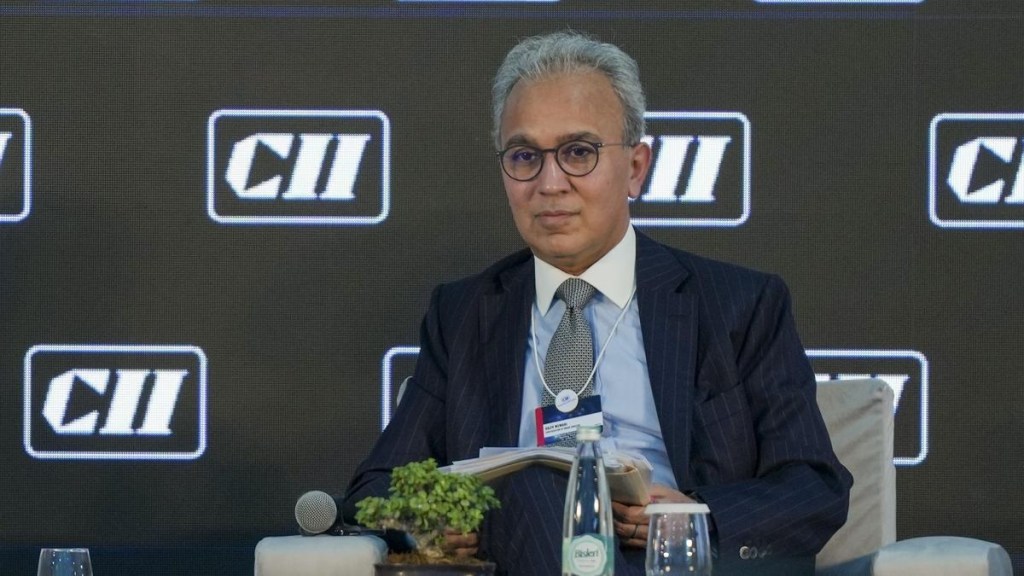The recent slowdown in private investment was due to global uncertainties and geopolitical issues, but these investments will pick up as soon as the dust settles, feels the Confederation of Indian Industry (CII) president Rajiv Memani. The government should consider monetising a portion of its Rs 50 lakh crore holding in listed companies to create a sovereign wealth fund to catalyse MSMEs or strategic sectors, including critical minerals, for greater economic benefits for the country, he explains Prasanta Sahu in an interview. Edited excerpts.
Why is the private sector not investing?
The private sector investment from 2022-23 onwards has been on the upswing. In the last 4-5 months, the number of new announcements has slowed down a little bit. I feel this is largely related to global events, external uncertainty, and, to some extent, because of demand not picking up to the extent anticipated, especially urban demand. But that’s a short-term issue. I think it should pick up again.
The private sector balance sheets are very strong. Companies understand that to create market capitalisation, you need growth. To build growth, you have to have capex. So, all those things are completely lined up. There has been some domestic consolidation, but not that much. So, a bias towards capex, and that will happen. The execution plan sometimes takes more time than what it is, and largely those issues are at the state level. Availability of manpower is also an issue.
Bank credit growth is slowing. Do you see a revival?
Credit growth is around 10% the first three months of the year (2025-26). It should have been 12-13%. The personal and mortgage loans are growing at a much faster pace. But 10% is reasonable, because there is some level of debt aversion. Companies are able to raise capital from stock markets while larger ones are sitting on surplus cash. Also, in the first 4-5 months, please remember that we’ve had very turbulent global headwinds.
Top conglomerates report a disproportionate share in corporate profits. Is this one of the reasons for the low investment rate?
I think that bigger corporations are investing quite a lot. The numbers that they are talking about are probably much more significant than what I have heard in the past. So, if they are able to execute their plans, then I think we should see a much higher capex growth, and all these things then will have a trickle-down effect.
Is there still a lot of red-tapism, undue investigations, harassment?
I would say that this government has done a lot of work on ease of doing business and reforms, and even if you look at the Jan Vishwas Bill, I think there were a lot of changes that were made about, criminal prosecution, etc. I won’t use the word red tapism or harassment, but I do feel that the number of procedures, the number of approvals that are required sometimes, are still high. A lot of them are at a state level, and they vary very significantly from state to state.
What would be your suggestion for the government’s disinvestment programme?
I think the value of government holdings in the markets is close to Rs 50 lakh crores. Even if a small fraction of that is sold, and that money is used, either to reduce debt, or create a sovereign wealth fund for strategic assets like rare earths and nuclear energy or supporting MSMEs, the value creation for the government will be much greater. Right now, there is enough liquidity. All global multinationals are trying to monetise a little bit in India to see how they can redeploy that capital or reduce their debt load. Lots of Indian companies are listing, and lots of startups are raising funds. Capital is available. The process is easy and simple. It should happen.
You have suggested a 3-tier GST slab at 5%, 28% and one between 12% and 18%. The items that attract 28% plus cess now suffer a levy between 29% and 50%. If the compensation cess goes, how the revenue will be protected under this slab?
When tax rates are reduced, there is greater economic buoyancy. Some items which are not necessarily luxury items should not be categorised in the 28% slab. If there is extremely high tax on some product like tobacco, one-off adjustments one can make, so that there is no big fall (in terms of revenues). But otherwise, oo much rate categorisation, again, leads to unnecessary complexity. Even in the 28% category, there are some products which can be retained at 28% or brought down, which have an an impact on items like refrigerators, cement and air conditioners.
How important is the Rs 1 lakh crore research, development and innovation fund for industry?
If the government provides long-term loans at zero interest or very low nominal interest, then the ability of a company to develop the technology, even if it takes three years or five years, is pretty significant. I think it’s a great incentive because there’s no excuse for companies to say capital is a constraint.

